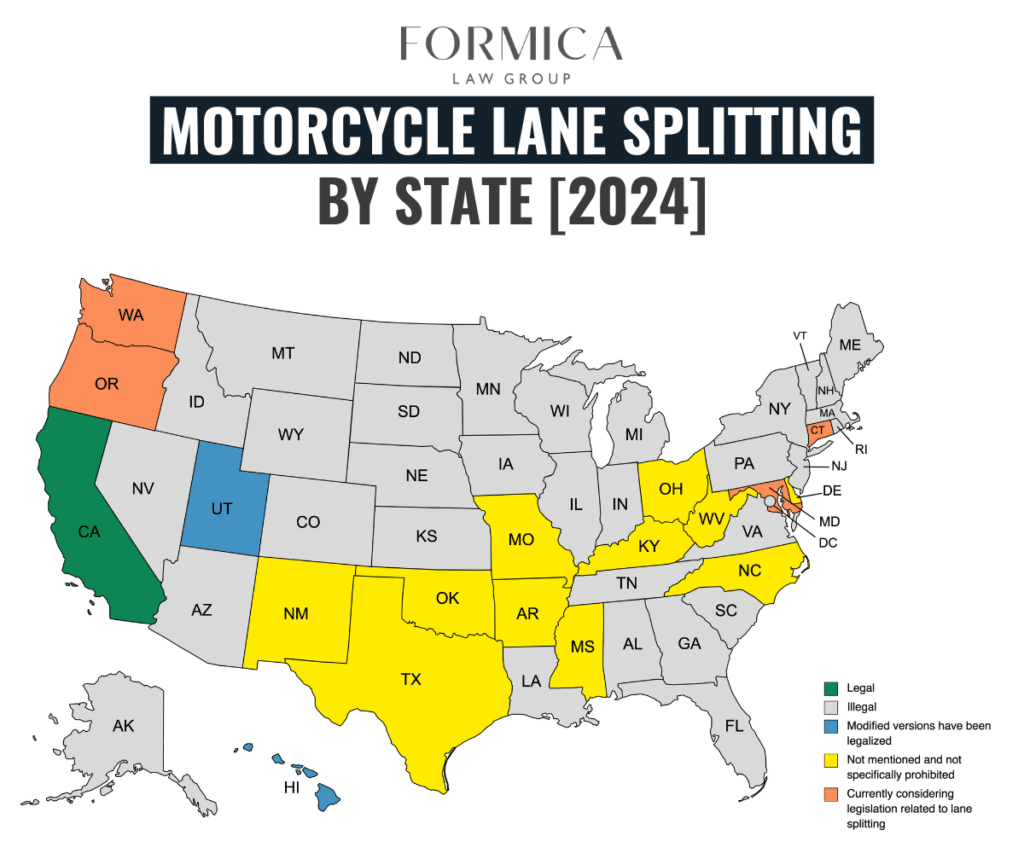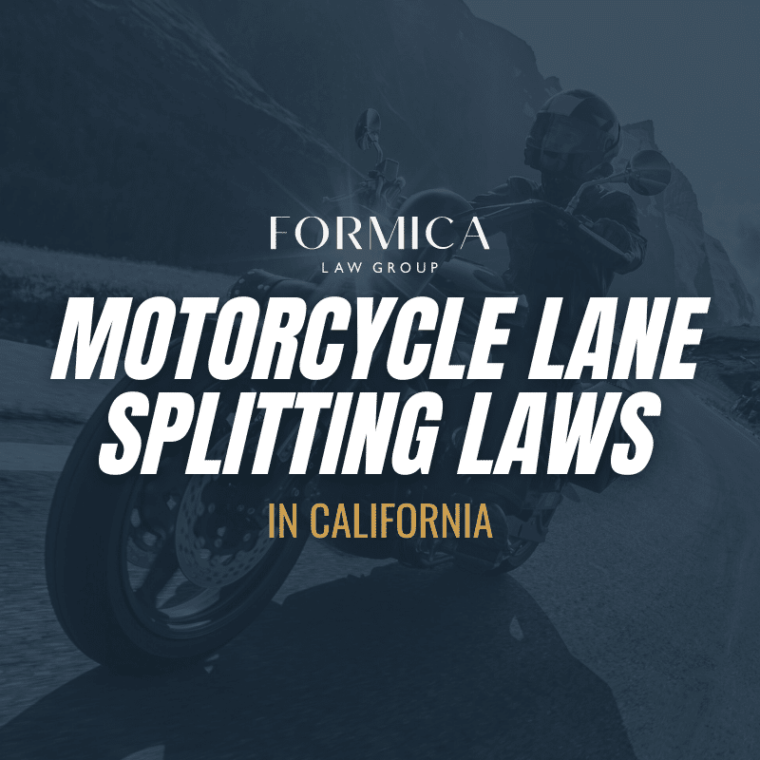Navigating the bustling streets of California, particularly in Los Angeles, can be a daunting task for motorcyclists. The intense traffic congestion often leads riders to seek alternative methods to make their commute smoother and more efficient. One such method is lane splitting, a practice that has been the subject of much debate and legislation. At Formica Law Group, our mission is to provide clarity on this topic, ensuring that motorcyclists understand their rights and responsibilities when it comes to lane splitting in California.
What is Lane Splitting?
Lane splitting, also known as lane sharing or white-lining, refers to the practice of riding a motorcycle between rows of slow-moving or stopped vehicles. This maneuver allows motorcyclists to bypass traffic, potentially reducing travel time and avoiding rear-end collisions that are common in heavy traffic situations.
Legal Status of Lane Splitting in California
California is the first state in the U.S. to formally legalize lane splitting. The practice was officially sanctioned with the passage of Assembly Bill 51 (AB 51) on January 1, 2017. This legislation provided a framework for the safe execution of lane splitting, empowering the California Highway Patrol (CHP) to develop specific guidelines for motorcyclists.
Assembly Bill 51 (AB 51)
AB 51 does not specify exact speeds or conditions under which lane splitting is allowed. Instead, it grants the authority to the CHP to establish guidelines that ensure the safety of both motorcyclists and other road users. The key points of AB 51 include:
- Legalization: Lane splitting is legal in California.
- Guidelines Development: The CHP is authorized to develop educational guidelines for motorcyclists and drivers about lane splitting.
CHP Guidelines for Lane Splitting
The CHP’s guidelines offer recommendations for safe lane splitting practices. While these guidelines are not legally binding, they are intended to promote safety and reduce the risk of accidents. Here are some of the essential points from the CHP guidelines:
- Speed Differentials: Motorcyclists should avoid traveling more than 10 mph faster than the surrounding traffic.
- Traffic Speed: Lane splitting is generally safer at speeds of 30 mph or less.
- Environment Awareness: Motorcyclists should be aware of their surroundings, considering factors such as the width of the lanes, the size of surrounding vehicles, and road conditions.
- Avoiding Blind Spots: Riders should avoid lane splitting next to large vehicles like trucks and buses, as these vehicles have significant blind spots.

Benefits of Lane Splitting
Lane splitting, when done correctly, can offer several benefits to both motorcyclists and the general flow of traffic:
- Reduced Traffic Congestion: By allowing motorcycles to move between lanes, overall traffic flow can improve, reducing congestion for all road users.
- Decreased Risk of Rear-End Collisions: Motorcyclists who lane split are less likely to be involved in rear-end collisions, which are common in stop-and-go traffic.
- Shorter Commute Times: Lane splitting can significantly reduce travel times for motorcyclists, making their commutes more efficient.
Risks and Challenges of Lane Splitting
Despite its benefits, lane splitting also presents certain risks and challenges:
- Visibility Issues: Motorcyclists may be less visible to drivers when lane splitting, increasing the risk of collisions.
- Driver Unfamiliarity: Not all drivers are familiar with or expect lane splitting, leading to potential misunderstandings and accidents.
- Speed Misjudgment: Misjudging speed differentials and gaps between vehicles can result in accidents.
Lane Splitting and Liability in Accidents
Understanding the legal implications of lane splitting is crucial, especially when it comes to liability in the event of an accident. In California, the concept of comparative negligence applies to traffic incidents involving lane splitting.
Comparative Negligence
Comparative negligence means that fault and liability for an accident can be shared among multiple parties. In the context of lane splitting, this means that both the motorcyclist and the other driver(s) involved can be assigned a percentage of fault based on their actions leading up to the accident.
For example, if a motorcyclist is lane splitting at a high speed and collides with a car changing lanes, both parties may share liability. The motorcyclist could be deemed partially at fault for exceeding safe speed differentials, while the driver might be at fault for not checking their blind spot.
Determining Fault
Determining fault in lane splitting accidents requires a thorough investigation of the circumstances. Factors that may be considered include:
- Speed of the Motorcyclist: Whether the motorcyclist was adhering to the CHP guidelines regarding speed differentials.
- Traffic Conditions: The density and speed of traffic at the time of the accident.
- Driver Awareness: Whether the driver was aware of the motorcyclist and took appropriate precautions.
- Lane Positioning: The position of the motorcyclist relative to other vehicles and the presence of any sudden lane changes.
Legal Representation for Lane Splitting Accidents
Given the complexities involved in lane splitting accidents, seeking legal representation is essential for protecting your rights and ensuring a fair resolution. At Formica Law Group, we specialize in personal injury cases involving motorcyclists, including those related to lane splitting.
How Formica Law Group Can Help
Our experienced attorneys can assist you in various ways:
- Accident Investigation: We conduct a comprehensive investigation to gather evidence and determine fault.
- Liability Assessment: Our team evaluates the circumstances of the accident to establish liability and build a strong case.
- Negotiation and Settlement: We negotiate with insurance companies on your behalf to secure fair compensation for medical expenses, property damage, and other losses.
- Court Representation: If necessary, we provide expert representation in court to ensure your rights are upheld.
Safety Tips for Lane Splitting
While lane splitting can be a safe and efficient practice, motorcyclists must exercise caution and follow safety guidelines to minimize risks. Here are some tips to help you lane split safely:
- Adhere to CHP Guidelines: Follow the CHP’s recommendations for speed differentials and traffic conditions.
- Stay Visible: Wear bright or reflective clothing and use your motorcycle’s headlights to increase visibility.
- Use Caution in Heavy Traffic: Be extra cautious when traffic is congested, as drivers may be more likely to make sudden lane changes.
- Stay Alert: Always be aware of your surroundings and anticipate the actions of other drivers.
- Practice Defensive Riding: Assume that other drivers may not see you and be prepared to take evasive action if necessary.
Injured In A Motorcycle Accident? Contact Formica Law Group
Lane splitting is a legally recognized practice in California, offering motorcyclists a way to navigate traffic more efficiently. However, it comes with its own set of risks and responsibilities. By understanding the legal framework, following safety guidelines, and seeking legal representation when needed, you can safely enjoy the benefits of lane splitting.
At Formica Law Group, we are dedicated to supporting motorcyclists in Los Angeles and beyond. If you’ve been involved in a lane splitting accident or have questions about your legal rights, don’t hesitate to contact us. Our team of experienced attorneys is here to help you every step of the way.
Contact Formica Law Group today at 323-272-3334 for a free consultation and learn more about how we can assist you in your motorcycle accident case. Let’s ensure you ride safely and confidently on California’s roads.

